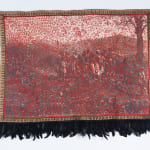Cian Dayrit
Neocolonial Landscape, 2020
Embroidery on fabric
155.5 x 125 cm
Copyright The Artist
Further images
The craft-y objects of Cian Dayrit often assume the form of embroidered textiles. As much a social activist and advocate as well as a visual artist, his practice collapses the...
The craft-y objects of Cian Dayrit often assume the form of embroidered textiles. As much a social activist and advocate as well as a visual artist, his practice collapses the various roles that he occupies, with fabric and needlework providing the material base for pointed commentary about the exploitation of indigenous communities, the abuse of land by political power, and the ravages of neoliberalism in his native Philippines. Neocolonial Landscape (2020) features a photograph taken by the American colonial official and zoologist, Dean Worcester, in 1901, of an Aeta circle dance.8 Worcester is infamously remembered today for his stand against Filipino independence from the United States, as for his published photographs that helped shape an image of the exotic alterity of the Philippines in the American mind. Against this picture of an indigenous ritual, framed by the gaze of colonial domination and captured by the superiority of the camera’s recording technology, Dayrit has had embroidered, in brilliant red thread, by hand, an imaginary topography that is informed by the displacement of Aeta communities from their ancestral lands in central Luzon today. The fictive terrain features, for instance, a long highway cutting through hills and rivers, boasting text in Tagalog that refers to a “pathway of big, fancy cars”, as well as a mountain that is dubbed the “sacred mountain that is about to be turned into a golf course”. While largely hypothetical, the artist’s mind-map nevertheless channels the circumstances that the Aeta are confronted with in the twenty-first century, in the face of large-scale infrastructural projects that have seen them increasingly exiled from their own homes.








